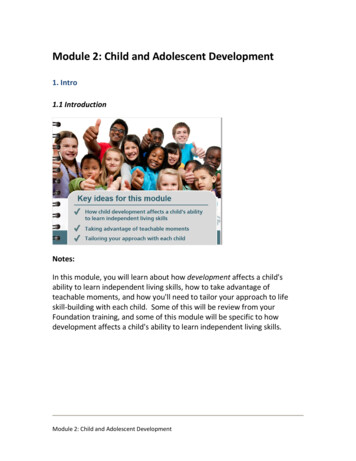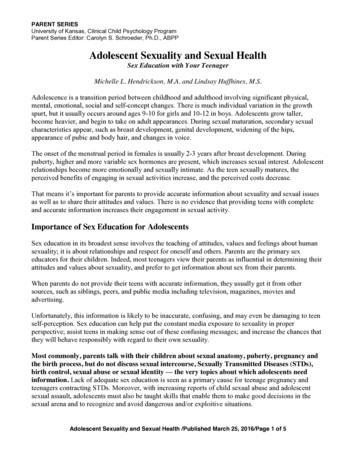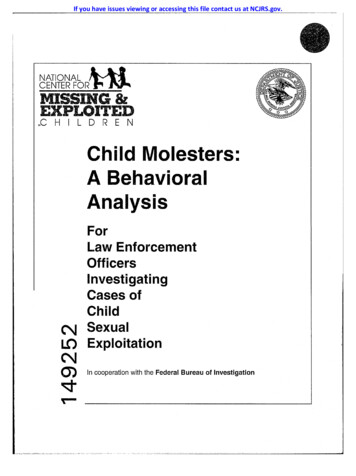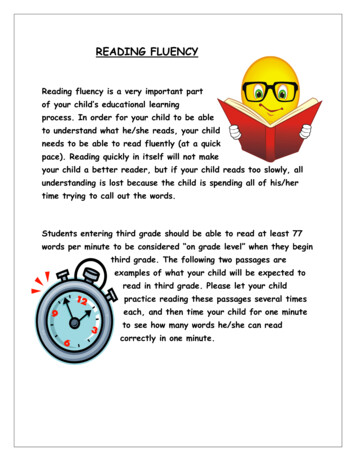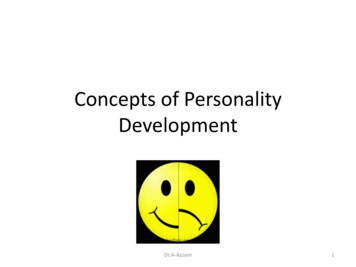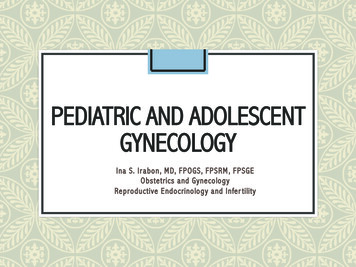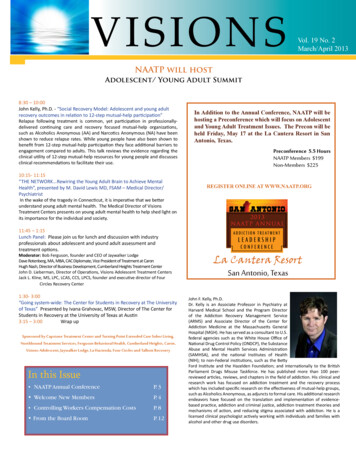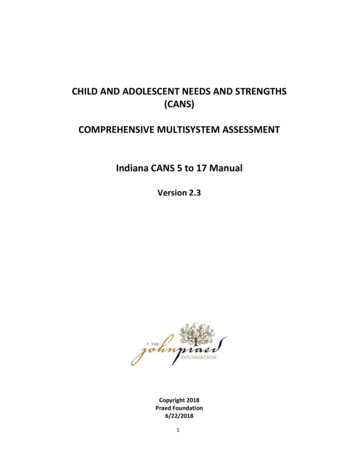
Transcription
CHILD AND ADOLESCENT NEEDS AND STRENGTHS(CANS)COMPREHENSIVE MULTISYSTEM ASSESSMENTIndiana CANS 5 to 17 ManualVersion 2.3Copyright 2018Praed Foundation6/22/20181
AcknowledgementsA large number of individuals have collaborated in the development of the CANS-Comprehensive tool.Along with the CANS versions for developmental disabilities, juvenile justice, and child welfare, thisinformation integration tool is designed to support individual case planning and the planning andevaluation of service systems. The CANS-Comprehensive is an open domain tool for use in servicedelivery systems that address the mental health of children, adolescents and their families. Thecopyright is held by the Praed Foundation to ensure that it remains free to use.For specific permission to use please contact the Foundation. For more information on the CANSComprehensive assessment tool contact:John S. Lyons, PhDSenior Policy FellowChapin Hall at the University of Chicago1313 East 60th StreetChicago, IL 60637jlyons@chapinhall.orgBetty A. Walton, Ph.D.Indiana University School of Social Work &Indiana Family Social Services AdministrationDivision of Mental Health and Addiction402 W. Washington Street, W353Indianapolis, IN 46204-2739Betty.Walton@fssa.in.govPraed n@yahoo.com2
The Child and Adolescent Needs and Strengths (CANS) is a multiple purpose information integration toolthat is designed to be the output of an assessment process. The purpose of the CANS is to accuratelyrepresent the shared vision of the youth/youth serving system—children, youth, and families. As such,completion of the CANS is accomplished in order to allow for the effective communication of this sharedvision for use at all levels of the system. Since its primary purpose is communication, the CANS isdesigned based on communication theory rather than the psychometric theories that have influencedmost measurement development. There are six key principles of a communimetric measure that apply tounderstanding the CANS.Six Key Principles of the CANS1. Items were selected because they are each relevant to service/treatment planning. An item existsbecause it might lead you down a different pathway in terms of planning actions.2. Each item uses a 4-level rating system that translates into action. Different action levels exist forneeds and strengths. For a description of these action levels please see below.3. Rating should describe the youth, not the youth in services. If an intervention is present that ismasking a need but must stay in place, this should be factored into the rating consideration andwould result in a rating of an “actionable” need (i.e. ‘2’ or ‘3’).4. Culture and development should be considered prior to establishing the action levels. Culturalsensitivity involves considering whether cultural factors are influencing the expression of needs andstrengths. Ratings should be completed considering the youth’s developmental and/or chronologicalage depending on the item. In other words, anger control is not relevant for a very young youth butwould be for an older youth or youth regardless of developmental age. Alternatively, schoolachievement should be considered within the framework of expectations based on the youth/youth’sdevelopmental age.5. The ratings are generally “agnostic as to etiology”. In other words this is a descriptive tool; it is aboutthe “what” not the “why”. Only one item, Adjustment to Trauma, has any cause-effect judgments.6. A 30-day window is used for ratings in order to make sure assessments stay relevant to thechild/youth’s present circumstances. However, the action levels can be used to over-ride the 30-dayrating period.History and background of the CANSThe CANS is a multi-purpose tool developed to support care planning and level of care decision-making, tofacilitate quality improvement initiatives, and to allow for the monitoring of outcomes of services. TheCANS was developed from a communication perspective in order to facilitate the linkage between theassessment process and the design of individualized service plans including the application of evidencebased practices.The CANS gathers information on youths and parents/caregivers’ needs and strengths. Strengths are thechild/youth’s assets: areas life where he or she is doing well or has an interest or ability. Needs are areaswhere a child/youth requires help or intervention. Care providers use an assessment process to get toknow the child or youth and the families with whom they work and to understand their strengths andneeds. The CANS helps care providers decide which of a child/youth’s needs are the most important toaddress in a treatment or service planning. The CANS also helps identify strengths, which can be the basisof a treatment or service plan. By working with the child/youth and family during the assessment process3
and talking together about the CANS, care providers can develop a treatment or service plan thataddresses a child/youth’s strengths and needs while building strong engagement.The CANS is made of domains that focus on various areas in a child/youth’s life, and each domain is madeup of a group of specific items. There are domains that address how the child/youth functions in everydaylife, on specific emotional or behavioral concerns, on risk behaviors, on strengths and on skills needed togrow and develop. There is also a section that asks about the family’s beliefs and preferences, and asection that asks about general family concerns. The care provider, along with the child/youth and familyas well as other stakeholders give a number action level to each of these items. These action levels helpthe provider, youth and family understand where intensive or immediate action is most needed, and alsowhere a youth has assets that could be a major part of the treatment or service plan.The CANS action levels, however, do not tell the whole story of a youth’s strengths and needs. Eachsection in the CANS is merely the output of a comprehensive assessment process and is documentedalongside narratives where a care provider can provide more information about the child/youth.History. The Child and Adolescent Needs and Strengths grew out of John Lyons’ work in modelingdecision-making for psychiatric services. To assess appropriate use of psychiatric hospital and residentialtreatment services, the childhood Severity of Psychiatric Illness (CSPI) tool was created. This measureassesses those dimensions crucial to good clinical decision-making for intensive mental health serviceinterventions and was the foundation of the CANS. The CSPI tool demonstrated its utility in informingdecision-making for residential treatment (Lyons, Mintzer, Kisiel, & Shallcross, 1998) and for qualityimprovement in crisis assessment services (Lyons, Kisiel, Dulcan, Chesler & Cohen, 1997; Leon, UzielMiller, Lyons, Tracy, 1998). The strength of this measurement approach has been that it is face valid andeasy to use, yet provides comprehensive information regarding clinical status.The CANS assessment builds upon the methodological approach of the CSPI, but expands the assessmentto include a broader conceptualization of needs and an assessment of strengths – both of the child/youthand the caregiver, looking primarily at the 30-day period prior to completion of the CANS. It is a tooldeveloped with the primary objective of supporting decision making at all levels of care: children, youthand families, programs and agencies, youth serving systems. It provides for a structured communicationand critical thinking about children/youth and their context. The CANS is designed for use either as aprospective assessment tool for decision support and recovery planning or as a retrospective qualityimprovement device demonstrating an individual child/youth’s progress. It can also be used as acommunication tool that provides a common language for all youth-serving entities to discuss thechild/youth’s needs and strengths. A review of the case record in light of the CANS assessment tool willprovide information as to the appropriateness of the recovery plan and whether individual goals andoutcomes are achieved.Training and periodic certification are required for providers who administer the CANS and theirsupervisors. Additional training is available for CANS SuperUsers as experts of CANS assessmentadministration, scoring, and use in the development of service or recovery plans.4
Measurement propertiesReliabilityStrong evidence from multiple reliability studies indicates that the CANS can be completed reliably byindividuals working with youth and families. A number of individuals from different backgrounds havebeen trained and certified to use the CANS assessment reliably including health and mental healthproviders, youth welfare case workers, probation officers, and family advocates. With approved training,anyone with a bachelor’s degree can learn to complete the tool reliably, although some applications ormore complex versions of the CANS require a higher educational degree or relevant experience. Theaverage reliability of the CANS is 0.78 with vignettes across a sample of more than 80,000 trainees. Thereliability is higher (0.84) with case records, and can be above 0.90 with live cases (Lyons, 2009). The CANSis auditable and audit reliabilities demonstrate that the CANS is reliable at the item level (Anderson et al.,2001). Training and certification with a reliability of at least 0.70 on a test case vignette is required forethical use. In most jurisdictions, re-certification is annual. A full discussion on the reliability of the CANSassessment is found in Lyons (2009) Communimetrics: A Communication Theory of Measurement inHuman Service Settings.ValidityStudies have demonstrated the CANS’ validity, or it’s the ability to measure and their caregiver’s needsand strengths. In a sample of more than 1,700 cases in 15 different program types across New York State,the total scores on the relevant dimensions of the CANS-Mental Health retrospectively distinguished levelof care (Lyons, 2004). The CANS assessment has also been used to distinguish needs of children in urbanand rural settings (Anderson & Estle, 2001). In numerous jurisdictions, the CANS has been used to predictservice utilization and costs, and to evaluate outcomes of clinical interventions and programs (Lyons,2004; Lyons & Weiner, 2009; Lyons, 2009). Five independent research groups in four states havedemonstrated the reliability and validity of decision support algorithms using the CANS (Chor, et al, 2012,2013, 2014; Cardall, et al, 2016; Epstein, et al, 2015; Israel, et al, 2015, Lardner, 2015).Rating needs & strengthsThe CANS is easy to learn and is well liked by children, youth and families, providers and other partners inthe services system because it is easy to understand and does not necessarily require scoring in order tobe meaningful to the youth and family. Basic core items – grouped by domain – are rated for all individuals.A rating of 1, 2 or 3 on key core questions triggers extension modules. Individual assessment module questions provide additional information in a specific area. 5
Each CANS rating suggests different pathways for service planning. There are four levels of rating for eachitem with specific anchored definitions. These item level definitions, however, are designed to translateinto the following action levels (separate for needs and strengths):Basic Design for Rating NeedsRating Level of NeedAppropriate Action0No evidence of needNo action needed1Significant history or possible needthat is not interfering withfunctioningWatchful waiting/prevention/additionalassessment2Need interferes with functioningAction/intervention required3Need is dangerous or disablingImmediate action/Intensive actionrequiredBasic Design for Rating StrengthsRating Level of StrengthAppropriate Action0Centerpiece strengthCentral to planning1Strength presetUseful in planning2Identified strengthBuild or develop strength3No strength identifiedStrength creation or identification may beindicatedThe rating of ‘N/A’ for ‘not applicable’ is available for a few items under specified circumstances (seereference guide descriptions). For those items where the ‘N/A’ rating is available, the N/A rating shouldbe used only in the rare instances where an item does not apply to that particular youth.To complete the CANS, a CANS trained and certified care coordinator, case worker, clinician, or other careprovider, should read the anchor descriptions for each item and then record the appropriate rating on theCANS form (or electronic record). This process should be done collaboratively with the child/youth,family and other stakeholders.Remember that the item anchor descriptions are examples of circumstances which fit each rating (‘0’, ‘1’,‘2’, or ‘3’). The descriptions, however, are not inclusive and the action level ratings should be the primaryrating descriptions considered (see page 6). The rater must consider the basic meaning of each level todetermine the appropriate rating on an item for an individual.The CANS is an information integration tool, intended to include multiple sources of information (e.g.,child/youth and family, referral source, treatment providers, school, and observation of the rater). As astrength-based approach, the CANS supports the belief that children, youth, and families have uniquetalents, skills, and life events, in addition to specific unmet needs. Strength-based approaches toassessment and service or treatment planning focus on collaborating with youth and their families todiscover individual and family functioning and strengths. Failure to demonstrate a child/youth’s skillshould first be viewed as an opportunity to learn the skill as opposed to the problem. Focusing onchild/youth’s strengths instead of weaknesses with their families may result in enhanced motivation and6
improved performance. Involving the family and child/youth in the rating process and obtaininginformation (evidence) from multiple sources is necessary and improves the accuracy of the rating.Meaningful use of the CANS and related information as tools (for reaching consensus, planninginterventions, monitoring progress, psychoeducation, and supervision) support effective services forchildren, youth and families.As a quality improvement activity, a number of settings have utilized a fidelity model approach to look atservice/treatment/action planning based on the CANS assessment. A rating of ‘2’ or ‘3’ on a CANS needsuggests that this area must be addressed in the service or treatment plan. A rating of a ‘0’ or ‘1’identifies a strength that can be used for strength-based planning and a ‘2’ or ‘3’ a strength that should bethe focus on strength-building activities, when appropriate. It is important to remember that whendeveloping service and treatment plans for healthy children and youth trajectories, balancing the plan toaddress risk behaviors/needs and protective factors/strengths is key. It has been demonstrated in theliterature that strategies designed to develop youth and youth capabilities are a promising means fordevelopment, and play a role in reducing risky behaviors.Finally, the CANS can be used to monitor outcomes. This can be accomplished in two ways. First, CANSitems that are initially rated a ‘2’ or ‘3’ are monitored over time to determine the percent of individualswho move to a rating of ‘0’ or ‘1’ (resolved need, built strength). Domain scores can also be generated byaveraging or summing items within each of the domains (Behavioral/Emotional Needs, Risk Behaviors,Functioning, etc.). These scores can be compared over the course of treatment. CANS dimension/domainscores have been shown to be valid outcome measures in residential treatment, intensive communitytreatment, foster care and treatment foster care, community mental health, and juvenile justiceprograms.The CANS is an open domain tool that is free for anyone to use with training and certification. There is acommunity of people who use the various versions of the CANS and share experiences, additional items,and supplementary tools.How is the CANS Used?The CANS is used in many ways to transform the lives of children, youth, and their families and to improveour programs. Hopefully, this guide will help you to also use the CANS as a multi-purpose tool. What isthe CANS?It is an assessment strategy. When initially meeting clients and their caregivers, this guide can be helpfulin ensuring that all the information required is gathered. Most items include “Questions to Consider”which may be useful in when asking about needs and strengths. These are not questions that must beasked, but are available as suggestions. Many clinicians have found this useful to use during initialsessions either in person or over the phone if there are follow up sessions required to get a full picture ofneeds before treatment or service planning and beginning therapy or other services.It guides care and treatment/service planning. When an item on the CANS is rated a ‘2’ or ‘3’ (‘actionneeded’ or ‘immediate action needed’) we are indicating not only that it is a serious need for our client,but one that we are going to attempt to work on during the course of our treatment. As such, when youwrite your treatment plan, you should do your best to address any Needs, Impacts on Functioning, or Riskfactors that you rate as a 2 or higher in that document.It Facilitates Outcomes Measurement. Many users of the CANS and organizations complete the CANSevery 6 months to measure change and transformation. We work with children, youth, and families andtheir needs tend to change over time. Needs may change in response to many factors including quality7
clinical support provided. One way we determine how our supports are helping to alleviate suffering andrestore functioning is by re-assessing needs, adjusting treatment or service plans, and tracking change.It is a Communication Tool. When a client leaves a treatment programs, a closing CANS may becompleted to define progress, measure ongoing needs and help us make continuity of care decisions.Doing a closing CANS, much like a discharge summary integrated with CANS ratings, provides a picture ofhow much progress has been made, and allowing for recommendations for future care which tie tocurrent needs. And finally, it allows for a shared language to talk about our youth and createsopportunities for collaboration. It is our hope that this guide will help you to make the most out of theCANS and guide you in filling it out in an accurate way that helps you make good clinical decisions.CANS: A behavior health care strategyThe CANS is an excellent strategy in addressing children and youth’s behavioral health care. As it is meantto be an outcome of an assessment, it can be used to organize and integrate the information gatheredfrom clinical interviews, records reviews, and information from screening tools and other measures.It is a good idea to know the CANS and use the domains and items to help with your assessment processand information gathering sessions/clinical interviews with the youth and family. This will not only helpthe organization of your interviews, but will make the interview more conversational if you are notreading from a form. A conversation is more likely to give you good information, so have a general idea ofthe items. The CANS domains can be a good way to think about capturing information. You can start yourassessment with any of the sections—Life Domain Functioning or Behavioral/Emotional Needs, RiskBehaviors or Youth Strengths, or Caregiver Resources & Needs—this is your judgment call. Sometimes,people need to talk about needs before they can acknowledge strengths. Sometimes, after talking aboutstrengths, then they can better explain the needs. Trust your judgment, and when in doubt, always ask,“We can start by talking about what you feel that you and your youth/youth need, or we can start bytalking about the things that are going well and that you want to build on. Do you have a preference?”Some people may “take off” on a topic. Being familiar the CANS items can help in having more naturalconversations. So, if the family is talking about situations around the youth’s anger control and then shiftinto something like---“you know, he only gets angry when he is in Mr. S’s classroom”, you can follow thatand ask some questions about situational anger, and then explore other school related issues that youknow are a part of the School/Preschool/Daycare module.Making the best use of the CANS. Children and youth have families involved in their lives, and their familycan be a great asset to their treatment. To increase family involvement and understanding, it is importantto talk to them about the assessment process and describe CANS and how it will be used. The descriptionof the CANS should include teaching the youth and family about the needs and strengths rating scales,identifying the domains and items, as well as how the actionable items will be used in treatment or servingplanning. When possible, have share with the youth and family the CANS domains and items (see theCANS Core Item list on page 11) and encourage the family to look over the items prior to your meetingwith them. The best time is your decision—you will have a sense of the timing as you work with eachfamily. Families often feel respected as partners when they are prepared for a meeting or a process. Acopy of the completed CANS ratings should be reviewed with each family. Encourage families to contactyou if they wish to change their answers in any area that they feel needs more or less emphasis.8
Listening using the CANSListening is the most important skill that you bring to working with the CANS. Everyone has an individualstyle of listening. The better you are at listening, the better the information you will receive. Some thingsto keep in mind that make you a better listener and that will give you the best information: Use nonverbal and minimal verbal prompts. Head nodding, smiling and brief “yes”, “and”—thingsthat encourage people to continue Be nonjudgmental and avoid giving person advice. You may find yourself thinking “if I were thisperson, I would do X” or “that’s just like my situation, and I did “X”. But since you are not that person,what you would do is not particularly relevant. Avoid making judgmental statements or telling themwhat you would do. It’s not really about you. Be empathic. Empathy is being warm and supportive. It is the understanding of another person fromtheir point of reference and acknowledging feelings. You demonstrate empathetic listening when yousmile, nod, maintain eye contact. You also demonstrate empathetic listening when you follow theperson’s lead and acknowledge when something may be difficult, or when something is great. Youdemonstrate empathy when you summarize information correctly. All of this demonstrates to theyouth or youth that you are with the youth. Be comfortable with silence. Some people need a little time to get their thoughts together.Sometimes, they struggle with finding the right words. Maybe they are deciding how they want torespond to a question. If you are concerned that the silence means something else, you can always ask“does that make sense to you”? “Or do you need me to explain that in another way”? Paraphrase and clarify—avoid interpreting. Interpretation is when you go beyond the informationgiven and infer something—in a person’s unconscious motivations, personality, etc. The CANS is not atool to come up with causes. Instead, it identifies things that need to be acted upon. Rather than talkabout causation, focus on paraphrasing and clarifying. Paraphrasing is restating a message very clearlyin a different form, using different words. A paraphrase helps you to (1) find out if you really haveunderstood an answer; (2) clarify what was said, sometimes making things clearer; (3) demonstrateempathy. For example, you ask the questions about health, and the person you are talking to gives along description. You paraphrase by saying “Ok, it sounds like is that right? Would you say that issomething that you feel needs to be watched, or is help needed?” Redirect the conversation to parents’/caregivers’/ own feelings and observations. Often, people willmake comments about other people’s observations such as “well, my mother thinks that his behavioris really obnoxious.” It is important to redirect people to talk about their observations: “so yourmother feels that when he does X, that is obnoxious. What do YOU think?” The CANS is a tool toorganize all points of observation, but the parent or caregiver’s perspective can be the most critical.Once you have the youth’s perspective, you can then work on organizing and coalescing the otherpoints of view. Acknowledge Feelings. People will be talking about difficult things, and it is important to acknowledgethat. Simple acknowledgement such as “I hear you saying that it can be difficult when “demonstratesempathy. Wrapping it up. At the end of the assessment, we recommend the use of two open-ended questions.These questions ask if there are any past experiences that people want to share that might be ofbenefit to planning for their young person, and if there is anything that they would like to add. This isa good time to see if there is anything “left over”—feelings or thoughts that they would like to sharewith you.9
Take time to summarize with the individual and family those areas of strengths and of needs. Helpthem to get a “total picture” of the individual and family, and offer them the opportunity to changeany ratings as you summarize or give them the “total picture”.Take a few minutes to talk about what the next steps will be. Now you have information organizedinto a framework that moves into the next stage—planning.So you might close with a statement such as: “OK, now the next step is a “brainstorm” where we takethis information that we’ve organized and start writing a plan—it is now much clearer which needsmust be met and what we can build on. So let’s start .”ReferencesAnderson, R.L. & Estle, G. (2001). Predicting level of mental health care among children served in adelivery system in a rural state. Journal of Rural Health, 17, 259-265.American Psychiatric Association (APA). (2013). Diagnostic and Statistical Manual of MentalDisorders, 5th Ed. (DSM-5). Washington DC: American Psychiatric Publishing.Chor, BKH, McClelland, GM, Weiner, DA, Jordan, N, Lyons, JS (2012). Predicting Outcomes ofChildren in residential treatment: A comparison of a decision support algorithm and amultidisciplinary team decision model. Children and Youth Services Review, 34, 2345-2352.Chor, B.K.H., McClelland, G.M., Weiner, D.A., Jordan, N., Lyons, J.S. (2013). Patterns of out ofhome decision making. Child Abuse & Neglect 37, 871-882.Chor, B.K.H., McClellean, G.M., Weiner, D.A., Jordan, N., Lyons, J.S. (2014). Out of homeplacement decision making and outcomes in youth welfare: A longitudinal study.Administration and Policy in Mental Health and Mental Health Services Research, 41,published online March 28.Cordell, K.D., Snowden, L.R., & Hosier, L. (2016). Patterns and priorities of service need identifiedthrough the Child and Adolescent Needs and Strengths (CANS) assessment. Children and YouthServices Review, 60, 129-135.Epstein, R.A., Schlueter, D., Gracey, K.A., Chandrasekhar, R. & Cull, M.J. (2015) Examiningplacement disruption in Child Welfare, Residential Treatment for Children & Youth, 32(3), 224-232.Israel, N., Accomazzo, S., Romney, S., & Slatevski, D. (2015). Segregated Care: Local area tests ofdistinctiveness and discharge criteria. Residential Treatment for Children & Youth, 32(3), 233250.Lardner, M. (2015). Are restrictiveness of care decisions based on youth level of need? Amultilevel model analysis of placement levels using the Child and Adolescent Needs andStrengths assessment. Residential Treatment for Children & Youth, 32(3), 195-207.Lyons, J.S. (2004). Redressing the Emperor: Improving the children’s public mental healthsystem. Westport, CT: Praeger Publishing.Lyons, J.S. (2009). Communimetrics: A communication theory of measurement in human servicesettings. New York: Springer.Lyons, J.S. Weiner, D.A. (2009) (Eds.) Strategies in Behavioral Healthcare: Assessment,Treatment Planning, and Total Clinical Outcomes Management. New York: Civic ResearchInstitute.10
Basic Structure of the CANS Comprehensive Tool for Youth 5 – 17The CANS Comprehensive Multisystem Tool expands depending upon the needs of youth and thefamily. Basic core items are rated for all youth and unpaid caregivers. Extension modules are triggeredby key core questions. A few additional questions are required for the decision models to function.Core ItemsLife Functioning DomainCaregiver Needs & Resources DomainFamily FunctioningLiving SituationSchoolSocial ommunicationDecision MakingJob FunctioningLegalMedical/PhysicalSexual DevelopmentSleepIndependent Living SkillsSupervisionInvolvement with CareKnowledgeOrganizationSocial ResourcesResidential StabilityPhysicalMental HealthSubstance UseDevelopmentalAccessibility to Child CareFamily StressSafetyMarital/Partner Violence in the HomeAbuse/NeglectChild Strengths DomainChild Behavioral /Emotional NeedsDomainFamily lTalents/InterestsSpiritual/ReligiousCommunity LifeRelationship PermanenceYouth Involvement with CareNatural tyDepressionAnxietyOppositionalConductAdjustment to TraumaAnger ControlSubstance UseChild Risk Behaviors DomainCultural Factors DomainSuicide RiskSelf MutilationOther Self HarmDanger to OthersSexual AggressionRunawayDelinquencyFire SettingIntentional MisbehaviorBullyingLanguageCultural IdentityTraditions and RitualsCult
Jun 22, 2018 · 3 The Child and Adolescent Needs and Strengths (CANS) is a multiple purpose information integration tool that is designed to be the output of an assessment process. The purpose of the CANS is to accurately represent the shared vision of the
